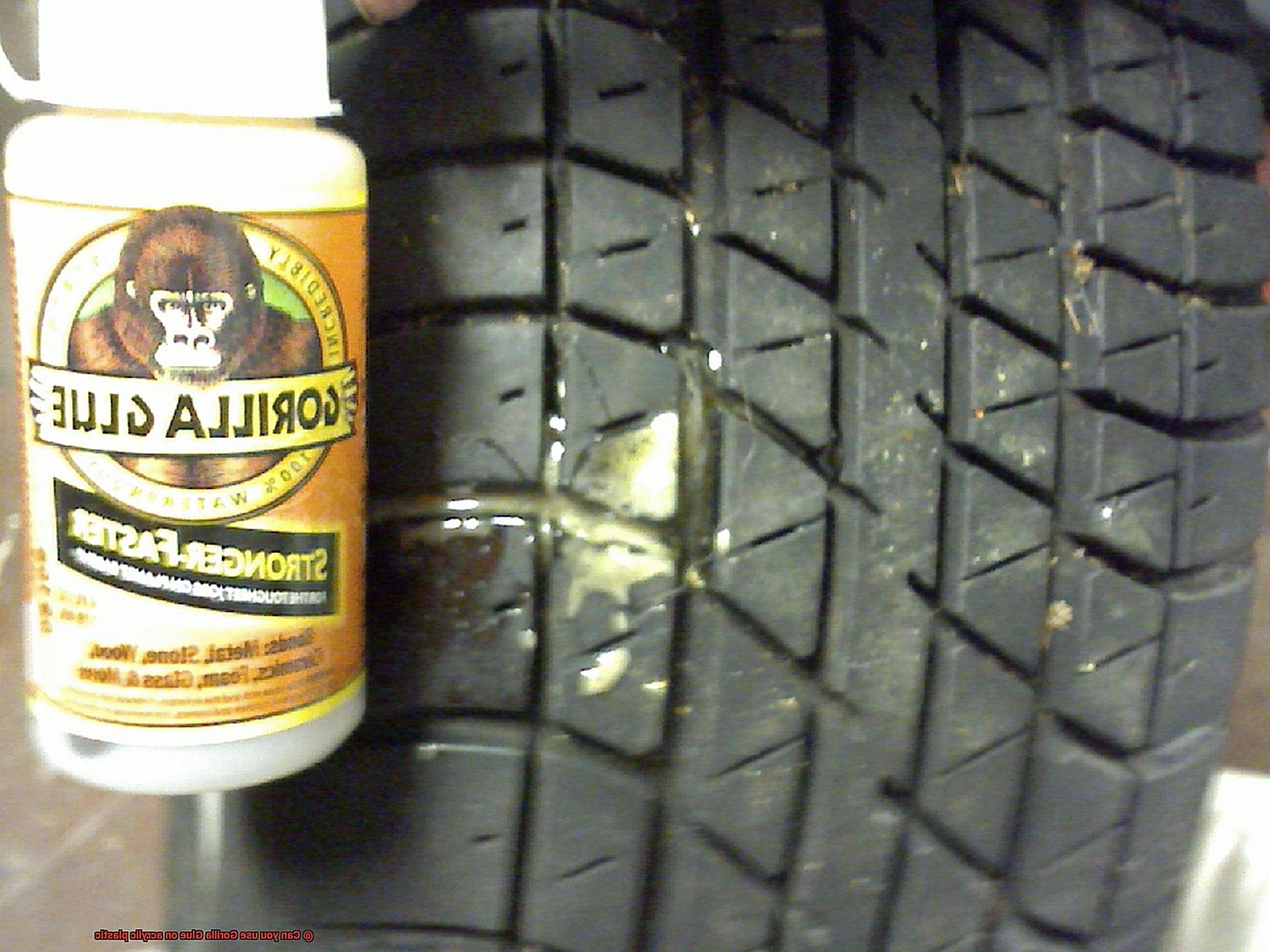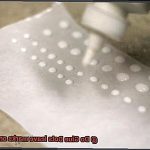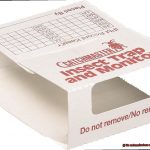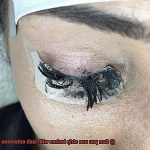If you’ve ever used Gorilla Glue, you know it’s like the superhero of adhesives – strong, versatile, and ready to tackle any project. But what about bonding acrylic plastic? Can Gorilla Glue handle that too? Well, in this blog post, we’re diving deep into the pros and cons of using Gorilla Glue on acrylic plastic. So whether you’re a newbie or a seasoned pro, get ready for some enlightening insights.
Now, let’s start with the good stuff. Gorilla Glue is famous for creating rock-solid bonds that can withstand just about anything. It works wonders on wood, metal, ceramics – you name it. And when it comes to acrylic plastic, which can be a bit fragile under pressure, a strong bond is crucial for long-lasting results. With Gorilla Glue by your side, you can count on sturdy support and a project that will stand the test of time.
But hold your glue gun for a sec – there are some things to consider before going all-in with Gorilla Glue on acrylic plastic. You see, acrylic is a special kind of thermoplastic that can be sensitive to certain chemicals. And guess what? Gorilla Glue expands as it cures. That means it might put some stress on your delicate acrylic surface. Plus, when it dries up completely, Gorilla Glue turns light yellow – not ideal if your acrylic is transparent or translucent.
So here’s the deal: using Gorilla Glue on acrylic plastic could work out just fine. But before you dive headfirst into your project, take a moment to do a small test on scrap acrylic plastic first. Grab some glue and apply it along with a clamp or pressure source to check how strong the bond is and if there are any unwanted reactions. This little test will save you from potential disasters and ensure a bond that’s both strong and easy on the eyes.
In the upcoming sections, we’ll explore these pros and cons in more detail, giving you practical tips to make an informed decision. Whether you’re a DIY enthusiast fixing up acrylic projects or a pro searching for the perfect adhesive, this guide has got your back.
So, stay tuned for our next blog post where we’ll dive deeper into the pros of using Gorilla Glue on acrylic plastic.
What is Acrylic Plastic?
Contents
- 1 What is Acrylic Plastic?
- 2 What is Gorilla Glue?
- 3 Can You Use Gorilla Glue on Acrylic Plastic?
- 4 Advantages and Disadvantages of Using Gorilla Glue on Acrylic Plastic
- 5 Alternative Adhesive Options for Bonding Acrylic Plastic
- 6 Surface Preparation for Bonding Acrylic Plastic
- 7 Expert Opinions on Using Gorilla Glue on Acrylic Plastic
- 8 Conclusion
Acrylic plastic, also known as polymethyl methacrylate (PMMA), is a remarkable material that has transformed various industries. Its transparency, durability, and ease of fabrication make it a preferred choice for numerous applications.
In this blog post, we will delve into the world of acrylic plastic, exploring its properties, uses, and why it’s not recommended to use Gorilla Glue directly on this material.
Properties and Uses:
- Transparency: Acrylic plastic allows around 92% of light to pass through, making it perfect for applications where clarity is essential. It finds use in display cases, signage, lenses, and windows.
- Durability: Unlike glass, acrylic plastic has excellent resistance to UV radiation, ensuring it doesn’t yellow or become brittle when exposed to sunlight for extended periods. It is ideal for outdoor applications like architectural glazing.
- Impact Resistance: Acrylic plastic is stronger than glass and less prone to breakage, making it safer in environments where safety is a concern. It is used in protective barriers, safety equipment, and automotive components.
- Ease of Fabrication: Acrylic plastic can be easily shaped, molded, or machined into various forms, allowing for intricate designs and customization options. This versatility makes it a preferred choice in furniture manufacturing, lighting fixtures, and point-of-purchase displays.
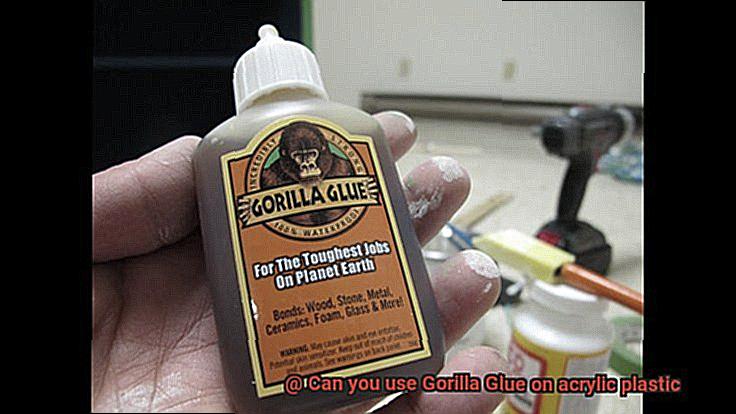

Why Gorilla Glue is not Recommended:
Gorilla Glue should not be used directly on acrylic plastic due to its expanding nature and potential chemical reactions. The pressure exerted by the expanding glue can deform or damage the acrylic surface. Additionally, certain components in the adhesive may react with the acrylic over time, causing brittleness or discoloration.
Alternative Adhesive Options:
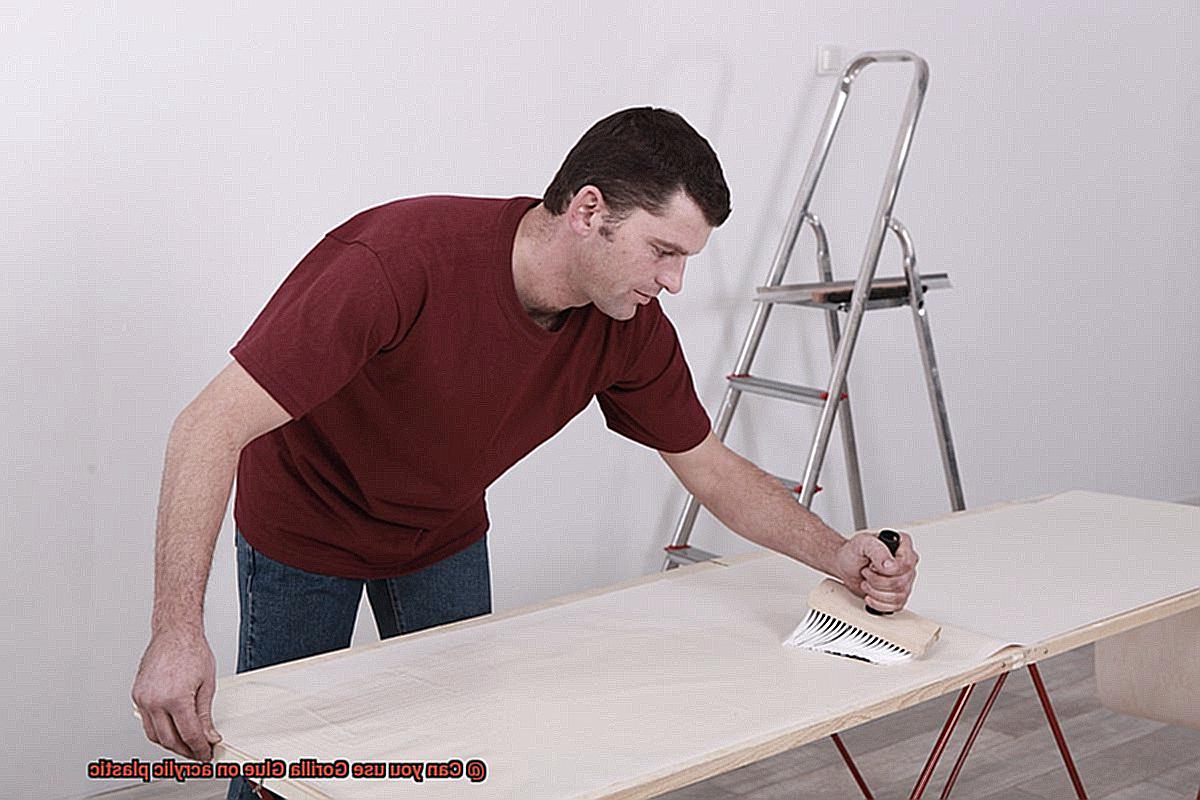
Instead of Gorilla Glue, use adhesives specifically formulated for bonding acrylic plastic such as solvent cement or acrylic glue. These adhesives soften the material and create a strong bond upon drying. Proper surface preparation, including thorough cleaning and slight roughening of the surfaces, is crucial for achieving the best results when bonding acrylic plastic.
What is Gorilla Glue?
Prepare to be amazed as we delve into the mesmerizing world of adhesive wonders with none other than Gorilla Glue. If you’ve ever pondered the secrets behind securely bonding different materials, your quest ends here. Gorilla Glue emerges as the ultimate savior, offering unparalleled strength, versatility, and reliability.
The Power of Holding:
Imagine this scene: a broken chair in dire need of repair, a wooden shelf yearning to be built, or a fragile ceramic pot begging for healing. Fear not. Enter Gorilla Glue, renowned for its extraordinary holding power capable of withstanding heavy loads and resisting impacts. Wood, metal, stone, ceramic, foam, glass – you name it, Gorilla Glue bonds them all.
The Secret Ingredient:
What makes Gorilla Glue an unstoppable force? It’s all thanks to the astonishing polyurethane resin it contains. This adhesive showcases remarkable durability and resistance to water, heat, and chemicals. Once dried, it forms a seamless tan-colored bond that can even be painted or stained to perfectly blend with the surrounding material.
Versatility at Its Finest:
Gorilla Glue harbors no bias when it comes to surfaces. Be it smooth, rough, porous, or non-porous – this glue tackles them all with effortless finesse. Like a matchmaker for dissimilar materials, it effortlessly creates powerful connections between them.
Tips and Tricks:
To unlock the full potential of Gorilla Glue, heed these invaluable tips from the pros. First and foremost, remember that moisture is key to proper curing. Dampen one of the surfaces before applying the adhesive for optimal bonding. Secondly, don’t forget to clamp or apply pressure during the curing process to forge an even mightier connection.
Conclusion:
In conclusion, Gorilla Glue stands tall as an indomitable force in the realm of adhesives. Its unmatched strength, versatility, and durability make it the go-to choice for countless DIY projects and professional applications. However, it’s important to note that for acrylic plastic, specialized adhesives may be better suited to maintain its integrity.
Can You Use Gorilla Glue on Acrylic Plastic?
While Gorilla Glue is a force to be reckoned with, the world of acrylic plastic requires a different kind of glue magic. Let’s dive into the fascinating realm of adhesives and discover why Gorilla Glue and acrylic plastic don’t always make the best match.
The Compatibility Conundrum:
Gorilla Glue, known for its impressive bonding capabilities across various materials, might seem like the go-to choice. However, when it comes to acrylic plastic, it’s essential to choose an adhesive wisely. Here’s why:
Moisture Matters:
Gorilla Glue is a moisture-activated polyurethane adhesive. It seeks moisture to cure and create a robust bond. Unfortunately, acrylic plastic is non-porous and doesn’t readily absorb moisture, making it challenging for Gorilla Glue to work its magic.
Expansion Blues:
As Gorilla Glue cures, it expands, exerting pressure on the surfaces it bonds. This property can spell trouble for delicate acrylic plastic, potentially leading to cracks or damage.
Specialized Solutions:
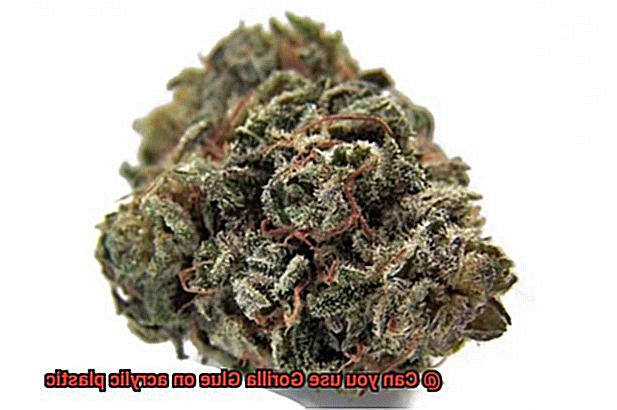
The adhesive world has a remedy tailor-made for acrylic plastic:
MMA Adhesives:
Methyl methacrylate (MMA) adhesives are specifically designed for bonding acrylic plastic. They boast exceptional strength, rapid curing times, and resistance to weathering and UV radiation. It’s no wonder MMA adhesives are favored in demanding industries like automotive and construction.
Cyanoacrylate (CA) Adhesives:
Also known as super glues or instant adhesives, CA adhesives are another viable option for acrylic plastic. They offer quick bonding, forming strong bonds on smooth surfaces like acrylic.
The Importance of Surface Preparation:
Before diving into the adhesive adventure, remember that proper surface preparation is key to success. Ensure the acrylic plastic surfaces are clean, dry, and free from contaminants or oils that could hinder adhesive performance.
While Gorilla Glue is a versatile adhesive superhero, it’s not the best companion for acrylic plastic. To achieve a bond that’s as strong as your DIY spirit, consider MMA or CA adhesives specifically designed for acrylic plastic. Don’t forget to prepare those surfaces properly and test compatibility beforehand.
Advantages and Disadvantages of Using Gorilla Glue on Acrylic Plastic
Before you dive in, it’s important to weigh the advantages and disadvantages of this adhesive. In this blog post, we’ll explore the pros and cons of using Gorilla Glue on acrylic plastic, as well as suggest alternative adhesives that may be better suited for your needs.
Advantages of Using Gorilla Glue on Acrylic Plastic:
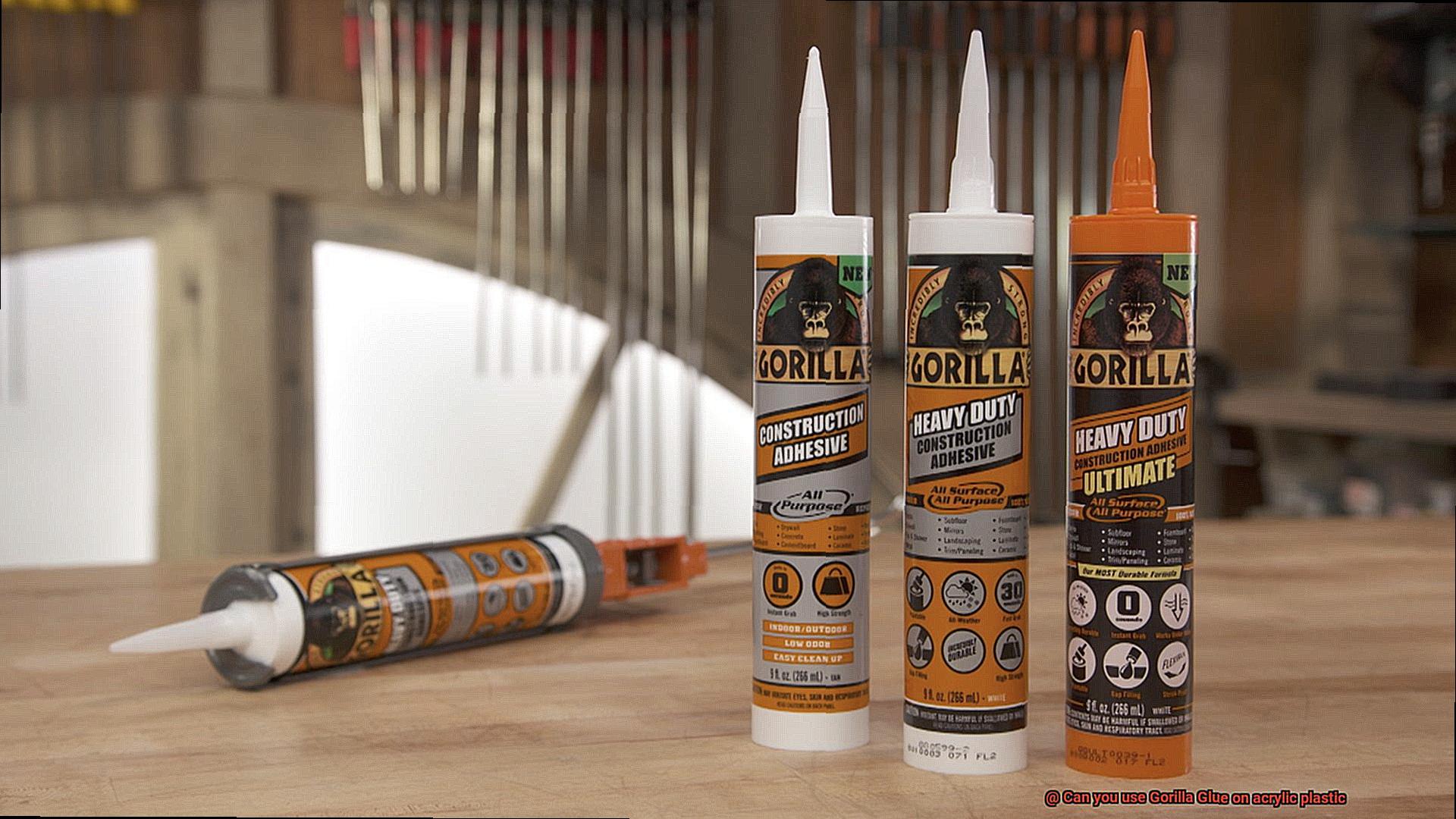
- Strong Bond: Gorilla Glue is renowned for its exceptional bonding strength. When used on acrylic plastic, it can create a sturdy and long-lasting bond that withstands stress and pressure.
- Versatility: Gorilla Glue is a versatile adhesive that can be used on various surfaces, making it convenient for a wide range of projects involving acrylic plastic. Whether you’re bonding acrylic to wood, metal, or glass, Gorilla Glue can get the job done.
- Water Resistance: Both Gorilla Glue and acrylic plastic are resistant to water, ensuring that the bond remains intact even in damp conditions. This makes it suitable for both indoor and outdoor applications.
Disadvantages of Using Gorilla Glue on Acrylic Plastic:
- Expanding Property: One drawback of Gorilla Glue is its expanding property as it cures. This can lead to excess glue seeping out from the bonded area, potentially marring the appearance of the acrylic plastic.
- Long Drying Time: Patience is key when using Gorilla Glue on acrylic plastic. It can take several hours to fully dry and cure, which may not be ideal for time-sensitive projects.
- Difficulty in Removing Excess Glue: Accidentally applied too much glue? Removing excess Gorilla Glue from acrylic plastic without damaging the delicate surface can be challenging.
Alternative Adhesives for Acrylic Plastic:
If Gorilla Glue doesn’t meet your needs, consider these alternative adhesives for acrylic plastic:
- Acrylic Adhesives: Specialized adhesives formulated specifically for bonding acrylic plastic offer excellent transparency, fast drying times, and strong bonds without damaging the material.
- Solvent Cement: Solvent cement chemically melts the surfaces of acrylic plastic, creating a strong bond that is nearly invisible.
Alternative Adhesive Options for Bonding Acrylic Plastic
When it comes to finding the right adhesive for bonding acrylic plastic, you may find yourself in a sticky situation. But fear not. In this post, we will explore a variety of alternative adhesive options that will help you make an informed decision.
First up on our list is solvent-based cement specifically designed for acrylics. These adhesives work by chemically melting the acrylic surfaces, creating a seamless and strong bond. Whether you prefer a liquid or gel form, these adhesives offer easy application and precise control. No more messy bonding.
Next, let’s talk about cyanoacrylate adhesive, also known as super glue or instant glue. These adhesives are fast-drying and provide a strong bond on various materials, including acrylic plastic. Just remember to clean the surfaces thoroughly before applying to ensure optimal bonding.
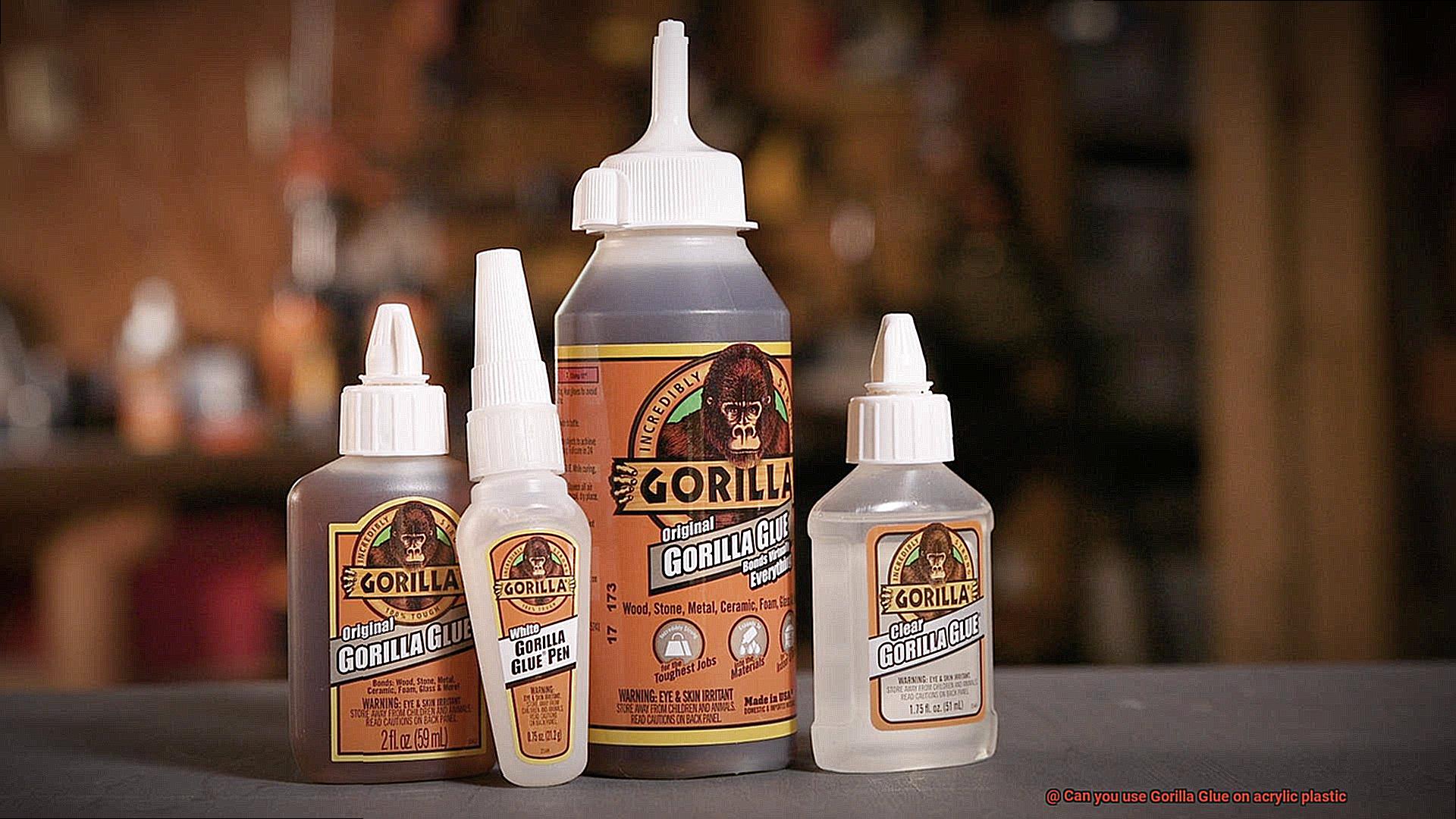
If you’re looking for something that can withstand high temperatures and resist chemicals, epoxy adhesives are the way to go. Made up of a resin and a hardener, epoxy creates a strong bond that can handle tough conditions. Keep in mind that curing times may be longer compared to other options.
For those in need of speed, UV-curing adhesives are the answer. These adhesives cure instantly when exposed to ultraviolet light, creating a durable bond in no time. Just make sure you have access to UV light sources for this option.
When selecting an adhesive, consider factors such as desired strength, curing time, and temperature resistance. Each option has its own advantages, so choose the one that best suits your specific application.
Remember, it’s always a good idea to consult with adhesive manufacturers or experts for personalized advice. They can guide you through the process and help you make the right choice.
Surface Preparation for Bonding Acrylic Plastic
Achieving a strong and durable bond when bonding acrylic plastic requires proper surface preparation. Whether you’re a DIY enthusiast or a professional, understanding the crucial steps involved in preparing the surface can make all the difference. Let’s explore the necessary techniques that will ensure your acrylic plastic bonds hold fast.
Step 1: Cleaning the Surface

Thoroughly clean the surface of the acrylic plastic using a mild detergent or specifically designed acrylic cleaner. This step removes any dirt, dust, grease, or residue that could hinder the bonding process. Rinse the surface with water and ensure it is completely dry before proceeding.
Step 2: Sanding the Surface
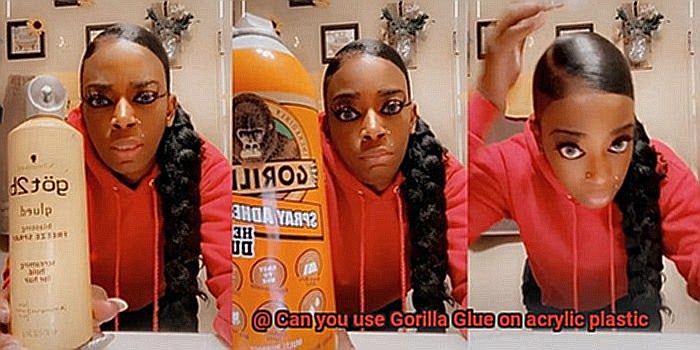
To enhance the bonding strength, gently sand the surface using fine-grit sandpaper. Acrylic plastic has a smooth and non-porous surface, making it challenging for adhesives to adhere effectively. By sanding, you create more surface area for the adhesive to grip onto, ensuring a stronger bond.
Step 3: Removing Sawdust
After sanding, eliminate any sawdust or debris from the sanded surface. Use a clean, lint-free cloth or compressed air to ensure no particles interfere with the adhesive bonding. A clean surface is essential for achieving optimal results.
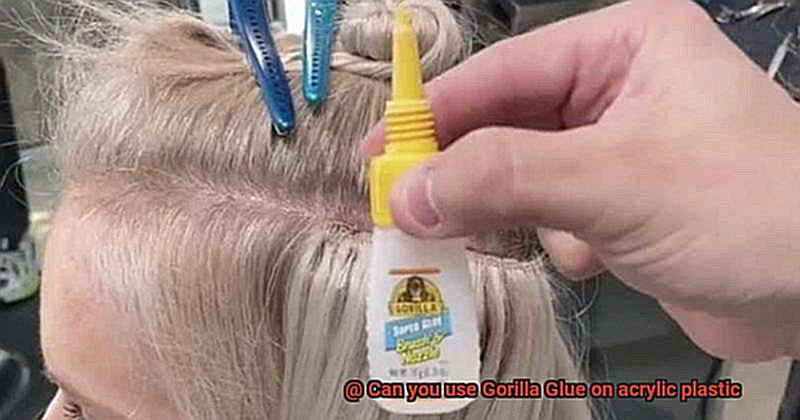
Step 4: Applying a Primer (optional)
Consider applying a primer specifically designed for acrylic plastics to further improve bonding strength. The primer creates a chemical bond between the acrylic and the adhesive, enhancing adhesion. Follow the manufacturer’s instructions carefully for proper application and drying time.
Step 5: Taping off Areas
To ensure a neat and clean bond on specific areas of the acrylic plastic, use masking tape or painter’s tape to mask off the surrounding areas. This prevents any accidental spreading of adhesive where it is not desired.
Step 6: Allowing Proper Curing Time
After applying Gorilla Glue or any other adhesive to the prepared surface of the acrylic plastic, exercise patience and allow sufficient curing time as per the manufacturer’s instructions. Rushing the bonding process can result in a weak bond or even failure. Allow the adhesive to work its magic.
Expert Opinions on Using Gorilla Glue on Acrylic Plastic
Pros of Using Gorilla Glue on Acrylic Plastic:
- Strong Bonding Properties: One of the key advantages of Gorilla Glue is its ability to create a strong bond. When used correctly, it has the potential to form a durable connection between acrylic plastic surfaces.
- Versatility: Gorilla Glue is a versatile adhesive that can be used on various materials, including acrylic plastic. This makes it a convenient option for a wide range of projects.
- Availability: Gorilla Glue is widely available in hardware stores, making it easily accessible for users who require an adhesive for bonding acrylic plastic.
Cons of Using Gorilla Glue on Acrylic Plastic:
- Lack of Specific Formulation: Gorilla Glue is not specifically formulated for use with acrylic plastic. As a result, there may be concerns about the reliability and longevity of the bond created between the two materials.
- Potential Damage to Acrylic Plastic: The chemical composition of Gorilla Glue includes polyurethane, which can have adverse effects on acrylic plastic if not used correctly. Improper application or excessive use of the adhesive may cause damage or discoloration to the plastic surface.
- Limited Resistance to Moisture and Extreme Temperatures: While Gorilla Glue offers excellent bonding strength, it may not provide sufficient resistance to moisture and extreme temperatures. If the bonded acrylic plastic will be exposed to these conditions, using adhesives specifically designed for them is advisable.
Expert Recommendations:
- Proper Surface Preparation: Experts emphasize the importance of adequately preparing the surface of acrylic plastic before applying Gorilla Glue. This includes cleaning the surfaces thoroughly, sanding them lightly to create a better bonding surface, and potentially using a primer for enhanced adhesion.
- Conduct a Small Test: Before applying Gorilla Glue on a larger area of acrylic plastic, experts recommend conducting a small test. Apply a small amount of the adhesive on a discreet area and allow it to cure fully. After curing, evaluate the strength and durability of the bond. This test will help determine if Gorilla Glue is suitable for your specific project.
- Consult Professionals: To ensure the best results, it is crucial to consult with professionals or manufacturers who specialize in acrylic bonding. They can provide expert guidance on choosing the right adhesive for your particular project and offer valuable insights based on their experience and knowledge.
OpncPeHjNWQ” >
Conclusion
The conclusion is clear: Gorilla Glue is not recommended for use on acrylic plastic.
It may seem like a strong adhesive, but when it comes to bonding acrylic, it falls short. Acrylic plastic requires a specialized adhesive that is specifically designed to bond with its unique properties.
So, if you’re working with acrylic, it’s best to opt for an adhesive that is formulated for this specific material.

